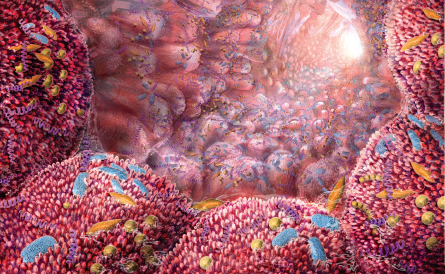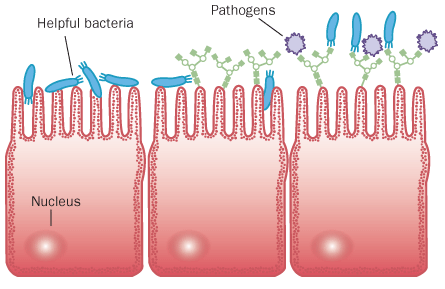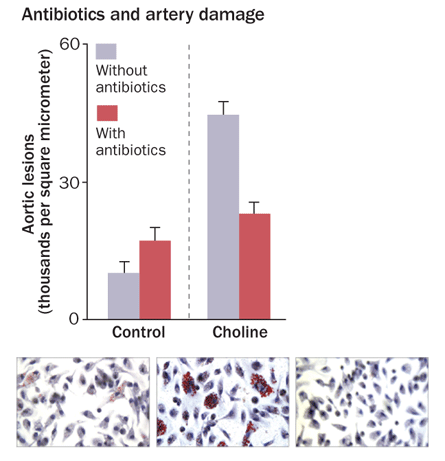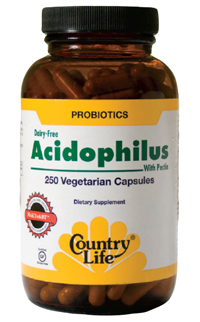Inside Job
Teams of microbes pull strings in the human body
- More than 2 years ago
You are surrounded, grossly outnumbered and being manipulated from within.




Teeming masses of bacteria are in your mouth, on your skin, up your nose and on the surface of your eye, in your stomach, deep in your bowels and well, just about everywhere. In fact, the number of bacterial cells you harbor exceeds the count of your own body’s cells by 10-to-1.
But don’t be too hasty in reaching for the disinfectant. You can’t wash these microbes away. Nor should you. They are — for the most part — friendly. So friendly that many scientists now view humans as conglomerate superorganisms composed of thousands of species. Scientists have dubbed this internal flora the “microbiome,” a nod to the little ecosystems that have blossomed in the body throughout human evolution.
These microbes are no mere hitchhikers. They’re hard at work cleaning up your insides and pumping out compounds that have all kinds of effects on health, development and perhaps even some behavior, emerging evidence suggests.
While humans are definitely in a relationship with microbes, the status of that relationship is probably best described as “It’s complicated.” On the positive side, studies show that intestinal bacteria help to digest food, provide key vitamins and even feed cells lining the intestines. Friendly microbes in the gut and vagina and on the skin can protect against infections from disease-causing bacteria and educate the immune system. Some bacteria in the mouth even help prevent tooth decay.
Other bacteria may turn out to be “frenemies.” These otherwise friendly microbes might break your heart and even control your brain. New experiments — mostly with mice — are uncovering secrets about how bacteria beguile, coax and outright manipulate their hosts, including humans.
And just as scientists are learning what these microbes are capable of, it’s starting to look like clean living is breaking up some of the healthy friendships between people and microbes, contributing to disease. Unfriending a bacterial buddy, even one that is sometimes disruptive, can have unforeseen and potentially unpleasant side effects.
Whether they’re helping or hurting, these trillions of tiny passengers are here to stay, so new research is mapping their preferred human habitats and figuring out what they do. Ultimately, understanding how bacteria operate inside their human hosts might reveal ways for humans to manipulate their own microbiomes to prevent or treat disease.
Meet your microbiome
Researchers are just beginning to compile a Who’s Who of human-inhabiting microbes (SN: 12/6/08, p. 11; SN Online: 11/5/09). But even when bacteria are identified, it’s often not clear which are do-gooders and which are troublemakers.
“We’ve moved away from saying ‘What are healthy bacteria?’ to ‘What are normal bacteria?’ ” says Julie Segre of the National Human Genome Research Institute in Bethesda, Md. Segre is one of the researchers taking inventory of the bacteria that grow on skin as part of the National Institutes of Health’s Human Microbiome Project. “Having acne — is it healthy? I don’t know, but it’s normal,” she says. The same goes for dandruff and other common microbe-related skin problems.
It may take a shift in the numbers of microbes in a mix to cause illness. Skewed microbial mixes have been fingered as contributors to obesity (SN: 6/17/06, p. 373) and high cholesterol. How much fat gets into the liver may also depend on the blend of bacteria in a person’s intestines, researchers at the University of North Carolina at Chapel Hill and colleagues reported in the March Gastroenterology.
In a study of bacteria inhabiting healthy women’s vaginas, Jacques Ravel of the University of Maryland School of Medicine in Baltimore and his colleagues found that each woman had one of five major communities of microorganisms. Four of the communities were dominated by types of Lactobacillus, bacteria like those found in yogurt that are well-known for making infection-fighting lactic acid, the researchers reported in the March 15 Proceedings of the National Academy of Sciences.
But the fifth group of bacteria contained few lactobacilli, which usually signals an infection. “If you were to give those samples to a physician, they would probably say the women were sick and had bacterial vaginosis,” Ravel says. In fact, the women were perfectly healthy. Some researchers think that what bacteria do is far more important than which bacteria colonize the body. In this case, even though most of the bacteria in the fifth group weren’t Lactobacillus, the microbes still made plenty of lactic acid that could ward off serious infections.
Bacteria can also have effects far beyond where they’re found in the body. Problems can arise in the heart, for example, from the digestive habits of bacteria in the gut. What intestinal bacteria eat usually depends on what the human host has for dinner. Just as eating lots of beans can cause bacteria to produce an embarrassing amount of certain gases, chowing down on meat, eggs and some fish can lead intestinal bacteria to produce substances that may hurt the heart more than the pride.
A study by Stanley Hazen of the Cleveland Clinic and his colleagues found that people who had heart attacks or strokes due to clogged arteries had higher blood levels of a substance made when bacteria break down a dietary fat than did people who didn’t have heart disease (SN Online: 4/7/11). The study, published in the April 7 Nature, showed that the people and their microbes ran a macabre relay, handing off metabolic by-products to each other in a race ending in cardiovascular disease.
Microbes as manipulators
The heart-breaking bacteria are just doing their jobs by breaking down a type of fat called lecithin. Other bacteria are far more direct in meddling with the goings-on of the human body.
Take a humble gut bacterium called Bacteroides fragilis. This species is ancient, at least 500 million years old, and has probably been living in the gut from humankind’s beginning, says Caltech microbiologist Sarkis Mazmanian. He and his colleagues showed that B. fragilis could prevent and cure inflammatory bowel diseases in animals, mostly by making a sugar coating called polysaccharide A. But no one knew how the sugar helps or why the bacterium makes the molecule.
“Is this bacterium really so altruistic that it is going to maintain expression of polysaccharide A for the exclusive benefit of the host?” Mazmanian wondered. Probably not. It turns out that the sugar helps keep the immune system calm so that it doesn’t toss B. fragilis and its bacterial buddies right out of the colon.
Polysaccharide A interacts with an immune-cell protein that normally turns on inflammation, yet this particular interaction actually turns off inflammation, Mazmanian and his colleagues reported in the May 20 Science. The inflammation-stimulating protein, called a Toll-like receptor, usually acts as a detector for pathogens. And indeed, if the bacterium doesn’t make the sugar, the immune system gears up, leading to inflammation.
“This organism is quite unusual because it doesn’t hide from the immune system, or disarm the immune system, but co-opts it,” Mazmanian says.
It’s not just the immune system that is subject to microbial manipulation. Bacteria help build the brain and influence behavior, scientists in Sweden and Singapore have learned.
Mice raised in environments without any bacteria were far more likely to take risks than mice that had a normal mix of microbes, Sven Pettersson, a cellular microbiologist at the Karolinska Institute in Stockholm and the Genome Institute of Singapore, discovered with his colleagues. Mice generally skulk around in shadows and stay close to walls, but that behavior may not be the mice’s idea alone.
Mice raised in a sterile environment were much bolder, literally going out on a ledge more often than mice reared with bacteria in their bellies, Pettersson’s team reported in the Feb. 15 Proceedings of the National Academy of Sciences. Bacteria-free mice were also more active overall than their bacteria-laden counterparts. Inoculating bacteria-free newborn mice with intestinal bacteria reversed the changes in behavior. But restoring gut bacteria in adult bacteria-free mice did not change the rodents’ behavior, indicating that whatever bacteria do to the brain, they do it early in life.
Bacteria’s presence or absence affected how the mice used certain brain chemicals and genes involved in brain development. Taken together, the results indicate that intestinal bacteria somehow shape the brain and make mice more anxious — or cautious, depending how you look at it, Pettersson says.
Translating these results to humans is tricky, though. Taking on friendly bacteria isn’t likely to make adventurous people more timid, and antibiotics won’t turn a shrinking violet into a daredevil.
“At the moment this applies only to rodents,” says Pettersson, “but I wouldn’t be surprised if we would find bacterial metabolites or bacterial signaling acting on the pregnant mother and affecting the development of the child.” If so, the findings could have implications for developmental disorders such as autism.
And bacterial influences are probably not all in the head. “It doesn’t take Einstein to realize that if you can do that for the brain, then symbiotic relationships could affect other organs in the body,” Pettersson says. “At the moment that’s just astrology, but it’s tickling to think about.”
Going germless
The thought of microbes controlling the body may tickle Pettersson, but most people are squeamish about even having bacteria around. “Everywhere you look people are trying to
make the world germfree,” says Martin Blaser, a microbiologist at New York University.
But a bacteria-free world is neither practical nor healthy. Blaser and others think that hygienic practices are not only getting rid of pathogens but are also causing populations of helpful bacteria to dwindle, leading to disease. This disappearing-microbiota theory is slightly different from the hygiene hypothesis, which holds that reduced exposure to pathogens leads to a maladjusted immune system, which in turn causes allergies and asthma (SN: 8/26/00, p. 134). Breaking up with the bacterial buddies that humans evolved with could have even more profound effects on health.
“Clean water is great. I wouldn’t choose otherwise, but sometimes there are unforeseen consequences,” Blaser says.
Consider Helicobacter pylori. These stomach bacteria have earned a bad reputation for causing ulcers and stomach cancer (SN: 9/1/07, p. 134), and most people have shed no tears over the organism’s declining presence in Europeans and North Americans. As the percentage of people carrying H. pylori has decreased, so have cases of ulcers and stomach cancer. But the loss of the bacteria is also associated with an increase in gastroesophageal reflux disease, Barrett’s esophagus (in which stomach acid damages the esophageal lining) and esophageal cancers. Those conditions are all caused by stomach acid getting into the esophagus; H. pylori helps reduce stomach acid production, partly by making its own version of an antacid.
People who have been treated with antibiotics to get rid of H. pylori also have higher levels of a hunger-inducing hormone called ghrelin in their stomachs. Blaser speculates that the loss of the bacteria may contribute to today’s obesity epidemic.
What’s more, people with H. pylori in their stomachs have lower risks of getting childhood asthma (SN: 8/16/08, p. 9) and allergies, and the organism’s disappearance may also be adding to the rise of those conditions.
Those are the potential consequences of getting rid of just one microbial frenemy. Treatments that disturb many microbes could have even more far-reaching consequences. A study published in the April Antimicrobial Agents and Chemotherapy showed that antibiotics altered the levels of 87 percent of the compounds made in mouse intestines by bacteria and the mouse hosts. Many biological processes that are also important for human health were affected, including production of bile salts and steroid hormones.
Blaser and others hope that as people become more aware of how important bacteria are to human well-being, gentler therapies might toss out the bad guys but keep the good.
It’s been slow in coming, but an awareness is growing that small creatures can wield great influence on the development of the human brain, immune system and other parts of the body. It should come as no great surprise, Mazmanian says. After all, bacteria shape their environments all the time, creating teeming colonies around vents in the ocean floor and helping build coral reefs and rain forests. “I don’t see us as being any different from a coral reef,” he says. “But humans are narcissists by nature, and most of the rest of the world isn’t ready to admit that little, ignorant bacteria could be in charge.”
Weeding the microbial garden

Some scientists aren’t content to kowtow to manipulative microbes. New methods aim to bend bacteria to people’s wills, or at least influence which microbes are allowed to take up residence. The task isn’t easily accomplished.
Antibiotics can change the body’s microbe composition, but the results are far from controllable, says Rob Knight, a microbial ecologist and Howard Hughes Medical Institute researcher at the University of Colorado at Boulder. “Antibiotics are like driving a bulldozer through your garden and hoping that what pops back up is what you want,” he says.
Powerful antibiotics such as ciprofloxacin (which gained fame as a treatment during the anthrax letter scare of 2001) can wipe out much of the gut’s microbial diversity. Some people’s bacterial populations rebound fairly quickly to their previous composition, Stanford researchers reported in the March 15 Proceedings of the National Academy of Sciences. Others never really recover, and repeated rounds of antibiotics lead to bigger and bigger shifts in community makeup.
Some people advocate supplements of bacteria, called probiotics, to boost friendly bacteria. Others favor prebiotics — chemicals to encourage certain bacteria to thrive. Clinical trials are trying to determine if those approaches will work.
Another treatment involves starting over with somebody else’s gut bacteria. In a few places doctors are performing fecal transplants to treat people with serious infections of Clostridium difficile. The bacterium causes severe diarrhea and can inflame and damage the colon to the point that part of the intestines must be surgically removed. The fecal transplant procedure “is exactly as disgusting as you would imagine,” Knight says. But transplanting a healthy person’s fecal bacteria into the sick person’s colon cures the disease in most people. Still, that’s a drastic measure and one most people aren’t likely to use to help mold their microbes. — Tina Hesman Saey







